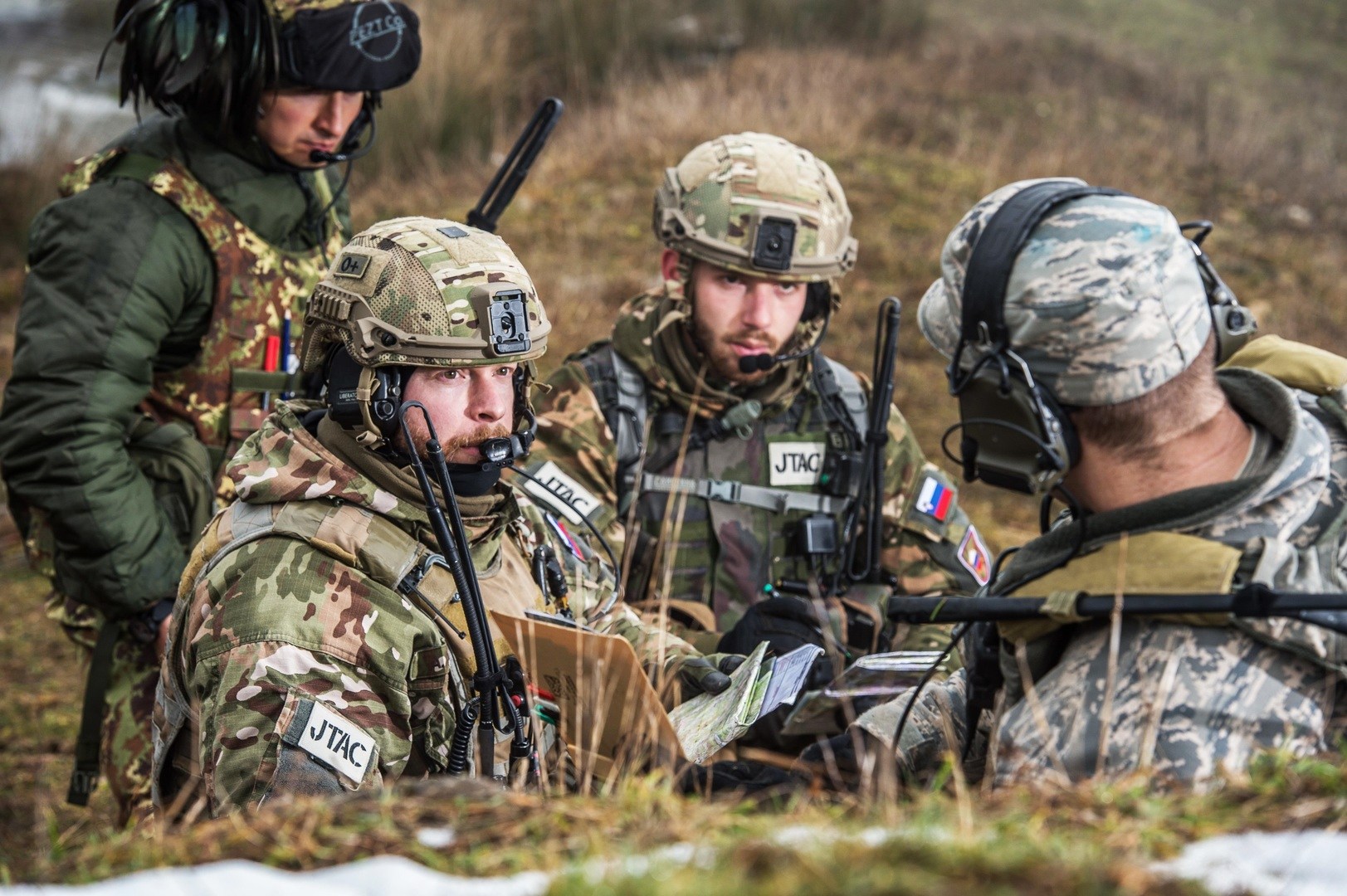
Insight By Intelsat General
Intelsat General advances ground force missions around the globe
With the introduction of FlexGround service earlier this year, Intelsat General has delivered on the promise of high-speed broadband to forces in remote areas.

This content is provided by Intelsat General.
By Raakesh Parmar
In any military operation, staying connected and moving rapidly is of critical importance. Ground forces must have the available bandwidth to enable all applications—sensor data, video transmission, and communications relay—to ensure mission success and troop safety.
In the past, military users had to choose between systems—one that provided enough bandwidth for all their applications, or one that was easily transportable: small in size, weight and power (SWaP).
Now, troops no longer have to choose.
With the introduction of FlexGround service earlier this year, Intelsat General has delivered on the promise of high-speed broadband to forces in remote areas.
An elegant solution to a global problem
By leveraging Intelsat’s multi-layered, Ku-band network and Intelsat EpicNG high-throughput satellite platform, FlexGround provides unprecedented data rate transmissions. This enables converged data, voice and video communications to the smallest, land mobile terminals, while meeting the high-definition full-motion video (HD FMV) needs of intelligence, surveillance and reconnaissance (ISR) applications. The combination of high data rates between 3-times and 10-times the speed of existing satellite networks, and the very small terminals provide the optimal solution for mobility without sacrificing speed.
Another challenge that military users face is service provisioning. In the past, organizations had to operate “Do-It-Yourself” satellite networks. In other words, they had to buy, build, operate and maintain an entire global satellite services infrastructure.
Oftentimes, the infrastructure was very expensive and time-consuming to manage; it also lacked full global coverage. As a result, users found themselves in situations where they didn’t have the bandwidth they needed at the right time or location. What they needed was a network that would support something similar to a cell phone plan that was available anytime, anyplace and at an affordable price.
As a managed end-to-end service, FlexGround takes the complexity out of SATCOM for our military users. It offers cost-effective, high-performance broadband connectivity to a wide range of military ground applications, including Communications-on-the-Pause, Manpack, and Emergency Responder communications. It’s a global service that provides service availability whenever and wherever needed.
It also gives government customers the ability to choose among several service options, including a pay-as-you-go option, allowing them to choose a plan based on their data rate usage and geographic and budgetary needs, without having to make an upfront commitment.
 Where FlexGround Eclipses Other Comms Options
Where FlexGround Eclipses Other Comms Options
Early entry. Organizations are particularly challenged in early entry or surge situations in austere locations. In these cases, the network infrastructure just isn’t there. Quite often, there’s no cell phone coverage, because there are no cell phone towers.
Nevertheless, these government customers—even early on—require broadband for data, voice, and video, not only for their operational requirements, but also for force protection. FlexGround is a clear candidate for its global footprint, its high-data rate transmissions, and the small SATCOM systems they enable. It provides the mobility troops need in the field without sacrificing performance.
HADR (Humanitarian Assistance Disaster Relief). In this case, a natural disaster (hurricane, wildfire, earthquake, etc.) destroys infrastructure. There are no terrestrial or cell phone towers left, and one of the top requirements is to restore communications as quickly as possible. Doing so will help support the work of first responders, coordinate activities across different humanitarian organizations, and connect those impacted with their loved ones and aid groups.
Continuity of Operations (COOP). Organizations must consider how to continue critical operations under a broad range of circumstances, and communications between organizations can help determine the success or failure of a mission. Often, in the more austere environments, organizations find that they don’t have adequate bandwidth or are vulnerable to jamming or terrestrial line cuts.
In the past, SATCOM as an alternate or complementary transport layer was considered attractive, but too expensive. FlexGround now enables SATCOM as a viable, even desirable, solution for COOP. Even in the event of a catastrophic terrestrial cut, FlexGround can serve as an interim solution until terrestrial service is restored. And the user doesn’t pay anything until they use it—it doesn’t get more affordable than that!
 A Multitude of Benefits
A Multitude of Benefits
- At Your Service. As an end-to-end managed service, FlexGround takes the guesswork out of determining whether bandwidth will be available where and when you need it, leaving your teams free to work on their mission-critical tasks, without owning or maintaining any Hub-based hardware.
- Global Availability. Leveraging Intelsat’s Ku-band satellite network, built around the latest high-throughput satellite technology, Intelsat EpicNG, users have access to Intelsat’s satellite and terrestrial network, covering 90% of the world’s population. This platform provides powerful localized spot beams, multiple layers of pre-committed capacity on the Flex network for redundancy, and enhanced interference mitigation, delivering the highest quality connectivity.
- Great for Mobility without Sacrificing Speed. These powerful satellites enable, for the first time, use of the smallest land mobile terminals (SWaP) that are tested, qualified, and approved to operate across Intelsat’s Flex network, delivering data rates of up to 10 Mbps x 3 Mbps. These grab-and-go terminals for both Manpacks and COTP easily fit in an overhead flight compartment or checked as baggage. Applications and systems are easy to operate and maintain, even by non-technical operators, providing wider use across the spectrum of user operations.
- Simplified Ecosystem. FlexGround also aggregates Intelsat’s space segment and the IntelsatOne ground infrastructure into a simplified, streamlined ecosystem. By having one cohesive network, our customers will immediately gain operational efficiencies.
- Affordable and Flexible Pricing. Designed with our customers in mind, only Intelsat General offers a multitude of pricing plans, from pay-as-you-go to monthly and unlimited options, as well as the capability to pool several terminals within the same subscription plan.
- The Most Secure Network with Unmatched Redundancy and Resiliency. Intelsat has the highest security posture in the commercial satellite industry, meeting and/or exceeding all DoD cybersecurity standards under the Risk Management Framework. They are the only operator with a third-party Service Organization Controls (SOC-3) accreditation through KPMG. Customers additionally have 24/7 access to the Intelsat Secure Operations Center for network monitoring, carrier activation, and troubleshooting.
 Poised for Change
Poised for Change
The good news is that the time is right for change. New satellite technologies, such as high-throughput satellites and easier-to-use terminals, are coming together at the right time. Governments are more receptive to managed services rather than a DIY approach.
This gives the U.S. government, for example, a great opportunity to refresh their systems and to finally get the performance, security and affordability that they’ve been seeking.
Of course, this requires a change in the way that the government looks at SATCOM. SATCOM is not “unique,” requiring a “special” solution—no more than terrestrial or cellular transport is unique. Once it’s understood that SATCOM is just another transport layer, we can treat it the same way we treat terrestrial or cellular service.
The government doesn’t own and operate terrestrial fiber or cellular infrastructure—it just wants the service. It also understandably doesn’t want to spend the money to establish and run these infrastructures; they’re not inherently government functions. Rather, the government can gain the same benefits from SATCOM (namely global flexibility, economies of scale, fast provisioning of service), if it starts to use a managed service like FlexGround.
The commercial SATCOM industry is ready and proven. Leaders like Intelsat have demonstrated their reliability in times of war and peace and are largely providing the majority of these services now. Once the government takes the final steps, it can take advantage of all the benefits that managed services offer.
For additional information, please visit the FlexGround website or download Intelsat’s white paper.
Copyright © 2024 Federal News Network. All rights reserved. This website is not intended for users located within the European Economic Area.




